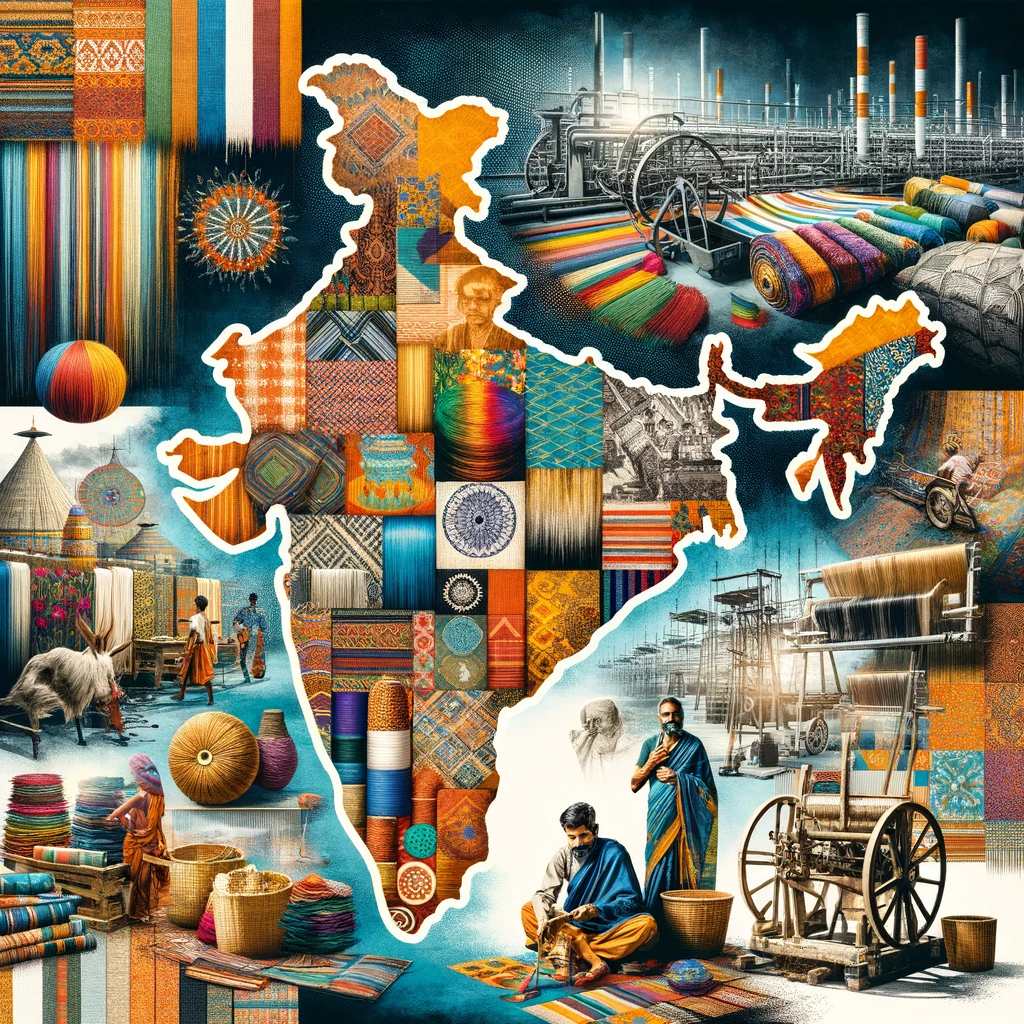The textile industry in India stands as a timeless emblem of the nation’s rich cultural tapestry and artisanal heritage. It’s a sprawling and vibrant sector that not only breathes life into the age-old traditions but is also a powerhouse of innovation and commerce.
| Key Takeaways from the Indian Textile Industry Analysis |
|---|
| Prowess of Tradition |
| India’s rich history in textile production sets it apart with its diverse traditional practices and a strong global cultural reputation. |
| Economic Significance |
| Textiles are a key sector in India’s economy, offering vast employment opportunities and significantly contributing to GDP and export earnings. |
| Industry Advantages |
| With a large labor force, diverse fabric supply, and a wide range of product manufacturing abilities, India has a unique competitive edge in the global textiles market. |
| Export Landscape |
| Indian textiles enjoy a robust global presence, with a wide variety of products satisfying the needs and wants of different international markets. |
| Market Challenges |
| India faces challenges such as fierce global competition, infrastructural gaps, and the need for more foreign investment and retail networks. |
| Roadmap for Growth |
| To overcome these challenges, policies such as liberalization of labor laws and modernizing trade agreements are pivotal, along with investing in technology and sustainable practices. |
Beginning with an illuminating foray into the vast expanse of India’s textile heritage, one immediately encounters the diverse array of fabrics and craftsmanship that paints a colorful portrait of India’s ancient civilization. The intricate weaves, the vibrant dyes, and the myriad patterns speak volumes of the artistic prowess that has been nurtured over the centuries.
Brief Overview of India’s Textile Industry
- Flourishing from the cotton fields to modern textile mills
- A holistic blend of traditional handloom and cutting-edge textile technology
Importance of Textile Exports to India’s Economy
The textile sector is not merely a cornerstone of cultural significance; it is a critical component of India’s economic engine. It is remarkable for its:
- Direct influence on the rural and urban employment sector
- Significant contribution to GDP and foreign exchange earnings
The symbiotic relationship between the growth of the textile industry and the overall economic development of the nation cannot be overstated. It is a vivid illustration of how a nation’s artisanal roots can evolve into a globally competitive industrial segment.
Through the dedication of craftspeople and the strategic efforts of the Indian government, the industry is set to retain its luster and fortify its global market share. An exploration of these threads reveals an enduring narrative of growth, innovation, and resilience.
India’s Textile Industry Advantages
Harnessing an array of strengths, India’s textile industry is laced with competitive advantages that set it apart on the global stage.
- Large and Relatively Low-Cost Labor Force
With a labor force that is as vast as it is skilled, the textile sector capitalizes on this resource to deliver an unrivaled combination of quality and value.

- Large Domestic Supply of Fabrics
The abundance of domestically produced fabrics means that the supply chain is robust and often self-sustaining. Learn about India’s diverse fabric supply here.
Ability to Manufacture a Wide Range of Products
- From luxurious silks to durable jute, the industry’s product range is extensive.
| Material | Description |
|---|---|
| Cotton | The backbone of Indian textiles |
| Silk | For opulent attire and furnishings |
| Wool | High-quality winter wear |
| Synthetic | Versatile and cost-effective |

- Strong and Diverse Raw Material Base for Manufacturing Natural and Artificial Fibers
This cornucopia of raw materials gives manufacturers the flexibility and resilience to cater to diverse markets.
India’s Textile Exports
- Overview of India’s Textile Exports
India’s textile exports are a testament to its global reach and its role as a key player in the international textiles market.

- Targeted Markets for Textile Exports
India’s textiles have found favor across the world, from the bustling markets of the Middle East to the fashion houses of Europe and the diverse consumer base of the U.S.
- Comparison of India’s Market Share with China’s
In a competitive comparison, India holds its own, particularly in segments like cotton and handcraft textiles where it has a distinct edge over China’s more machine-centric approach.
Constraints on India’s Textile Industry
Despite its strengths, the industry does face a tapestry of challenges.
- Increased Global Competition
The industry must navigate a landscape peppered with international rivals.
- Weak Infrastructure
Logistics and power supply inconsistencies can be stumbling blocks for smooth operations.
- Lack of Foreign Investment
Foreign investments could propel technological upgrades and infrastructural improvements.

Overcoming Constraints
To weave past these constraints, strategic policies and actions are a necessity.
- Policies to Allow for Success
Government initiatives, such as the ‘Make in India’ campaign, aim to stimulate growth and modernization.
- Liberalization of Contract Norms
The push for more flexible labor laws and contract regulations could liberate manufacturers from bureaucratic tangles.
Summing up, the advantages of India’s textile industry lay a vibrant foundation for its success. Yet, in the shadow of these strengths lie constraints that need addressing.
The path forward is laced with both promise and challenges, but with the right policies and support, the Indian textile industry’s potential to scale global heights is a fabric of reality waiting to be woven.
Through the dedication of craftspeople and the strategic efforts of the Indian government, the industry is set to retain its luster and fortify its global market share. An exploration of these threads reveals an enduring narrative of growth, innovation, and resilience.
India’s Textile Industry Advantages
The Indian textile industry is not only a cultural touchstone but also a bastion of economic strength boasting myriad advantages. Let’s unravel the fabric of benefits that bolster India’s textile sector.
Large and Relatively Low-Cost Labor Force
India’s sweeping labor pool is a key ingot in its industrial armament. Abundant and cost-effective, the workforce stands as the industry’s spine, offering:
- Skilled artisans and a burgeoning cadre of young professionals
- Low labor costs that translate to competitive pricing on the global stage
This workforce is pivotal in driving both the handloom sector and the burgeoning machine-led textile production.
Large Domestic Supply of Fabrics
The industry is nourished by an extensive supply chain of indigenous fabrics. The plethora of materials ranges from cotton and silk to jute and synthetics. This rich cornucopia places India in a self-sufficient stance, trimming the dependency on imports, providing stability, and fostering rapid response to market demands.
Ability to Manufacture a Wide Range of Products
Diversity is in the warp and weft of India’s textile narrative. Manufacturers can deftly pivot across a broad spectrum of textiles to cater to various market segments:
| Segment | Products |
|---|---|
| Apparel | Ethnic wear, Western attire, workwear, and high-fashion couture |
| Home Furnishings | Bed linens, curtains, upholstery, and other home textiles |
| Technical Textiles | Medical textiles, agro textiles, and automotive fabrics |
| Handicrafts | Traditional weaves, embroidery, and regional artistic textiles |
Strong and Diverse Raw Material Base for Manufacturing Natural and Artificial Fibers
India’s repository of raw materials is both sprawling and variegated. It maintains a strong foothold in both natural fiber production—ranking among the top producers of cotton, jute, and silk—and the artificial fiber domain with a growing synthetic and blended textile manufacturing capacity.
The stages of this textile ecosystem include:
- Agriculture: Cotton fields, sericulture for silk, and other fiber-producing endeavors
- Production: Spinning, weaving, processing, and finishing
- Retailing: A vast network from local bazaars to global retail brands
India has an intrinsic capacity to produce a full array of textile products, adding resilience to its market stance and enabling it to tackle a sweep of consumer preferences.
Strong Government Support
The Government of India has continually offered its hand in patronage with favorable trade policies, subsidies, and initiatives aimed at amplifying growth. Initiatives such as the Technology Upgradation Fund Scheme (TUFS) bolster technological upgrades and efficiency improvements in the textile sector.
Export Competitiveness
The industry also garners strength from its export competitiveness. Traditional craftsmanship fused with contemporary designs makes Indian textiles a sought-after commodity worldwide. Moreover, the trade agreements India has with several countries smooth the path of textiles to foreign markets.
India’s textile smorgasbord is indeed one poised for global success, provided the country plays its cards right in navigating the industry’s intricate lattice of opportunities and challenges. As India continues to enhance its textile prowess, it remains an influential force shaping the global textile narrative, positioning itself as a formidable contender alongside its main rival, China.
In the following section, we shall explore India’s textile exports and how they cast a wide net across the international markets, contributing to the country’s burgeoning trade portfolio.
India’s Textile Exports
India’s textile exports are an intricate patchwork of tradition, quality, and innovation that stretches across the globe. The tapestry of products exported is as rich and diverse as the country’s cultural heritage. Here’s a detailed look at the vectors and volume of India’s textile export terrain.
Overview of India’s Textile Exports
India’s reputation as a global textile hub is backed by solid figures. As the second-largest textile exporter in the world, it contributes significantly to the global textile and apparel trade.
- Flourishing export markets for Indian textiles include the United States, European Union, Middle East, and Japan.
- The sector’s agility to adapt to trends and consumer demand ensures its export basket remains both varied and vibrant.
Targeted Markets for Textile Exports
India’s textile exports span across a diverse geography. Each market has a tailored approach, with customized products suiting regional preferences and styles.
- United States: Largest buyer of Indian textiles, favoring both high-quality garments and intricately designed ethnic wear.
- European Union: Prefers sustainable and eco-friendly textiles, with a growing demand for organic cotton.
- Middle East: Leans towards elaborate and embellished apparel, reflecting the region’s luxurious tastes.
- Japan: Values traditional Indian textiles for their authenticity and craftsmanship.
Comparison of India’s Market Share with China’s
In contrasting India’s textile market share with China’s, a fascinating dynamic surfaces.
- While China leads in mass-produced garments and technical textiles, India shines in niche areas of handlooms, handicrafts, and organic fabrics.
- India tends to have a cost advantage in cotton and labor-intensive textile segments, whereas China pivots on economies of scale and advanced manufacturing.
| Market Segment | India’s Position | China’s Position |
|---|---|---|
| Cotton Textiles | Strong | Competitive |
| Handloom & Craft | Dominant | Less Focused |
| Synthetic Textiles | Growing | Established |
Challenges and Opportunities in Export Markets
Despite its strengths, India’s textile industry faces challenges, such as:
- Regulatory Hurdles: Tariffs and non-tariff barriers in various countries.
- Market Penetration: Surmounting established trade through innovative and strategic market entry actions.
- Sustainability: Meeting the increasing global standards for environmentally friendly products.
Capitalizing on opportunities requires a focused approach:
- Trade Deals: Negotiating favorable terms in free trade agreements.
- Market Diversification: Exploring untapped markets and expanding existing ones.
- Supply Chain Modernization: Upgrading procurement, production, and logistics for efficiency.
Continuing this discourse, the subsequent section will address the bottle-necks hampering India’s textile sector and the strategic measures to alleviate these roadblocks.
In the final segment, we will wrap up our journey, summarizing India’s textile industry’s potentials and limits, and forecast the looming prospects for India’s textile exports.
Constraints on India’s Textile Industry
Despite its colorful and potent panorama, the fabric of India’s textile industry is interwoven with challenges that could temper its global aspirations. Understanding these constraints is fundamental for strategizing an efficient response that could sustain and boost the sector’s growth trajectory.
Increased Global Competition
As emerging economies and established markets alike add their threads to the global textile canvas, India feels the pressure of the competition. Countries like Bangladesh, Vietnam, and Cambodia are carving out their segments, often powered by lower wages and favorable trade agreements.
Weak Infrastructure
India’s expansive geography complicates its logistical framework. Inconsistencies in power supply, transportation, and technological adaptation can throttle the industry’s efficiency, causing delays and cost overruns.
Lack of Foreign Investment
Despite its potential, India’s textile sector could benefit greatly from an infusion of foreign capital. Such investments could trigger advancements in technology, scaling of operations, and enhancement of market reach, positioning India more robustly on the global map.
Need for Better Network and Retail Outlets
Expanding into the global market isn’t just about production—it’s also about placement. India faces a pressing need for a more penetrative retail network that can propel its textiles to prominence in global marketplaces.
Overcoming Constraints
The challenges are apparent, but not insurmountable. With a strategic playbook, India can embroider its path to success, ensuring these constraints are but temporary knots in an otherwise seamless garment of growth.

Policies to Allow for Success
A slew of policy reforms could serve as the spindle to India’s ambitions:
- Streamlining business regulations to invite and expedite foreign direct investments.
Liberalization of Contract Norms for Textile and Garments
Adjustments to labor laws could add flexibility and fluidity to the workforce, driving both domestic and international investors’ confidence.
Sharing Profit by Loyalty Bottom Up and Patronization from Above Downwards
Engaging the workforce with profit-sharing incentives could entice higher productivity levels. Furthermore, top-tier patronage, potentially from larger conglomerates, could foster a chain of support and development.
Conclusion
India’s textile industry is an enchanting interlace of opportunities and challenges, reflective of the country’s inherent dichotomy between tradition and modernity. The strengths of the sector form a resilient base that allows it to remain competitive and dynamic in the face of global changes.
While the constraints present real hurdles, the various policies and advancements in the pipeline—supported by the government and private sector alike—illustrate a collective endeavor to overcome these barriers. The fusion of the country’s traditional know-how with cutting-edge innovations poises the textile sector to weave India’s growth story in the fabric of global trade.
As the Indian textile industry threads through tradition and globalization, its capacity to adapt and evolve will determine its place in the ever-changing panorama of international commerce. With a canvas this broad and bountiful, the opportunity for India to not only maintain but expand its textile legacy is a possibility that lies within grasp—an opportunity that the nation is all set to sew into a success story.






